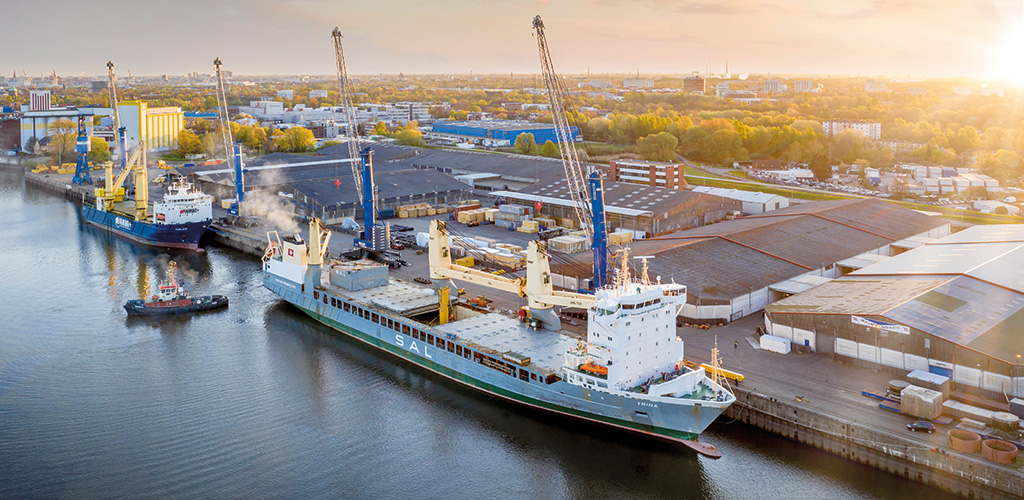Jun 23 | 2021
SAL, Jumbo’s Partnership Finds Market Sweet Spot

 By Carly Fields
By Carly FieldsWhen Netherlands-based Jumbo Shipping announced its joint venture with Hamburg’s SAL Heavy Lift, it was greeted with little fanfare. Pre-Covid, partnering up with past rivals was widely accepted as a necessary step for small to medium-sized operators looking to compete in a market where operating margins dipping below breakeven was the norm, not the exception. Which was the environment Jumbo and SAL faced when their management first broached the subject of an alliance in 2019. Fast-forward two years and with the detail agreed, the Jumbo-SAL-Alliance entered into being in a very different era.
Speaking with Breakbulk, Felix Peinemann, vice president of sales shipping at Jumbo, and Jens Baumgarten, managing director at SAL Heavy Lift, acknowledged the fortuitous timing of the joint venture’s launch, with freight rates at record highs and strong demand for multipurpose vessels, or MPVs.
“It’s not a secret that the market is rapidly developing,” Baumgarten said. The scale of growth has, however, been unexpected, he added. “Even the experts were not expecting such a fast turnaround in the markets.” The about-face was heavily driven by the wind energy renewable market, although the executives note high demand for MPV capacity from across other sectors too.
There is another important dif-ference in today’s market, compared with 2019 when the joint venture was first mooted: today, direct buyers, forwarders and brokers are seeking firm cover longer out. “So, spot which was typically four to six weeks is now 10 to 12 weeks or even more because people are frightened about the available capacity,” Baumgarten said. This dynamic is also supporting recovery, although he noted that there is a question mark over how long the uptick will last. “We are positive seeing the projects which are on the horizon, but it was a very fast flight and now we have to see if it will be really something which lasts to 2022/2023.”
Baumgarten added that almost all indicators, indices and prices that drive the market are “really jumping at the moment.” This presents a risk in itself: if they surge too high, projects could get delayed or simply become too expensive. “There will definitely be a market reaction to this high demand, which we will see in the next few months to come.”
Spanner in the Works
Not only was the actual joint venture process long in the planning, it also had to contend with the arrival of Covid-19 at the start of 2020. While it evidently didn’t derail the progress of the joint venture, the pandemic did complicate the coming together of the two teams and the ironing out of operational wrinkles.
Peinemann admitted that the preparations were much easier pre-pandemic: “It was a lot easier before Covid, as then you had the chance to physically meet. As you might imagine, when you are working on such an alliance, you would like to sit together one, two or three days in a room and go through things.”
Over the two years of discussions, Peinemann said both companies established a very good, open family relationship. “I know when I call Jens in the morning, I will get what I need. We know that we can count on each other. Everybody in this was really very open-minded. We had to ignore that we have been competing for quite a while and start talking to each other and find common grounds to work together.”
One aspect key to the successful outcome of the joint venture negotiations was the hands-on involvement of the operational teams. While the decision to form the joint venture came from top management, middle management were encouraged to be involved in the process from the start. The principals were acutely aware that for the partnership to work, both sides needed to take their people with them on the journey. “We can only do this if the people talk to each other and have a positive feeling, because if you have one side holding back and saying, ‘I’m not trusting my counterpart,’ then you’re already on the wrong foot,” Peinemann said.
That both companies are family owned is a happy coincidence and was not a prerequisite for the partnership. Many MPV operators have a similar set of vessels, services and markets covered, Baumgarten noted, so having the same or similar owner structure is an advantage, but not a driving factor in forming this partnership. Both executives firmly dismissed the idea of the joint venture being a precursor to a merger.
Business as Usual
For customers, nothing much has changed, Peinemann and Baumgarten said. “Our main driving factors here are not to confuse our clients and to serve our clients even better than before with an expanded service,” Peinemann said. “It will continue to be one person who responds to the request of the client, because otherwise it is just confusing,” Baumgarten added. “All over the world we are merging offices and agents so that we have one representation. We work together, we sit together, we have the same IT environment.”
He noted that ensuring a unified approach to clients has been paramount, so both companies have worked hard to achieve this. By the end of 2021, both expect greater advantages for clients with wider geographical representation, freedom of vessels, greater flexibility, and increased safety for the execution of projects.
Currently, the focus is on aligning the many regional offices of the two companies, but that will not necessarily lead to layoffs. “We are basically freeing up some manpower which we definitely need to develop our set-ups and concentrate on new markets, and so on, so there will be no cuts at all,” Baumgarten said. This, combined with the synergies of costs saved and merged offices, will bring additional benefits in the medium term.
Excited by Wind
In terms of cargo hotspots, both operators are excited about the offshore wind prospects opening up to MPVs in the current market. With the sector taking off, both Jumbo and SAL recognize the need for a very strong presence, which cannot be covered by just one or two companies operating in a silo. “Even under the Jumbo-SAL-Alliance, we are still, to a certain extent, a little bit short-staffed,” Peinemann admitted. “For example, we’d like to continue more and more for the module segment, especially for FPSOs,” or floating production storage and offloading units.
Looking at the size of upcoming projects in the offshore wind sector, and seeing how big the projects there will be, Peinemann added that it will be very difficult for a single entity to perform. “It may be that on one project you will be forced to team up with somebody because the reality is, we would like to serve all our clients. What we cannot afford to do is to put all our eggs in one basket, serving just one client for one big project. We need to have flexibility.” This flexibility is a key point and if reaching that goal means partnering with other competitors, so be it, Peinemann said.
Flexibility also applies on the engineering, procurement and construction company side, with Peinemann noting that clients are increasingly expecting their service providers to be more adaptable. “Cargo readiness versus pickup date is really something which is playing a key factor. It is mandatory that you can offer this flexibility to the clients. With the highest spectrum of vessels which we operate we can give this flexibility. This allows the Jumbo-SAL-Alliance to ‘protect the project.’”
Another shipper trend is increasing demand for availability of all services from one source. Operators today needs to be able to offer on a “best-for-project” basis. For the Jumbo-SAL-Alliance this means having the right ship for the right cargo and not dictating to the client which ship they have to use for their cargo. To allow this, an operator needs to have a “critical mass,” Peinemann said. “And with the new fleet, we are able to really come in with a smaller ship when the client has a smaller parcel, but also with a bigger ship if they need that. We can now offer all under one umbrella.”
Fleet renewal is also on the cards with Baumgarten confirming that discussions have taken place on new builds. But with yards backed up with container ship orders, the arrival of new capacity will be some years off, meaning that the newest joint venture on the breakbulk block can sit pretty with its expanded fleet and celebration-worthy freight rates well into 2022.
Carly Fields has reported on the shipping industry for the past 21 years, covering bunkers and broking and much in between.
Image credit: Jumbo
